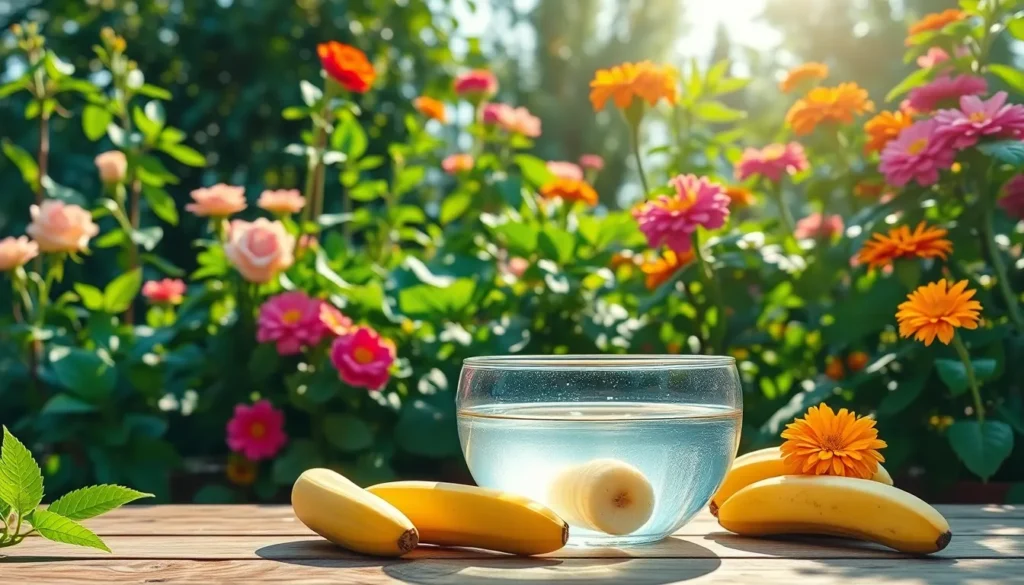We’ve all heard about expensive plant fertilizers and complex nutrient answers but what if we told you that one of the most effective plant boosters is hiding in your kitchen right now? Banana water – the liquid gold made from banana peels – has become a gardening game-changer that’s taking the plant community by storm.
This simple DIY fertilizer packs a powerful punch of potassium phosphorus and other essential nutrients that plants absolutely crave. Instead of tossing those banana peels in the trash we can transform them into a nutrient-rich elixir that promotes healthier growth stronger roots and more vibrant blooms.
Whether you’re nurturing houseplants or tending to your outdoor garden banana water offers an eco-friendly and budget-friendly solution that delivers real results. We’ll show you exactly how to make this miracle plant food and why it’s become every gardener’s secret weapon.
What Is Banana Water for Plants and How Does It Work
Banana water transforms discarded banana peels into a liquid fertilizer that delivers essential nutrients directly to your plants. This simple extraction process releases the concentrated minerals stored within the peels into water.
Natural Potassium Source for Plant Growth
Banana peels contain approximately 42% potassium by dry weight, making them one of the richest natural sources of this essential plant nutrient. Potassium strengthens plant cell walls and improves their ability to resist diseases and pests.
We’ve observed that plants receiving banana water develop stronger stems and more vibrant foliage compared to those without supplemental potassium. This mineral also regulates water uptake in plants, helping them maintain proper hydration levels during stress periods.
Plants use potassium to activate over 60 enzymes involved in growth and metabolism. Flowering plants particularly benefit from adequate potassium levels, as this nutrient promotes larger, more colorful blooms and extends flowering periods.
Slow-Release Nutrient Benefits
The soaking process gradually extracts nutrients from banana peels over 24 to 48 hours, creating a gentle fertilizer that won’t burn plant roots. This slow extraction mimics natural decomposition, providing nutrients at a pace plants can easily absorb.
Unlike synthetic fertilizers that deliver an immediate nutrient spike, banana water releases minerals steadily over several days after application. This sustained feeding reduces the risk of nutrient runoff and ensures plants receive consistent nourishment.
We recommend applying banana water every two weeks during growing season to maintain optimal nutrient levels. The gradual release system means plants won’t experience the shock that sometimes occurs with concentrated chemical fertilizers.
Phosphorus and trace minerals in banana water complement the potassium content, creating a balanced nutrient profile that supports overall plant health. These secondary nutrients work together to improve root development and enhance the plant’s natural defense mechanisms.
How to Make Banana Water Fertilizer at Home
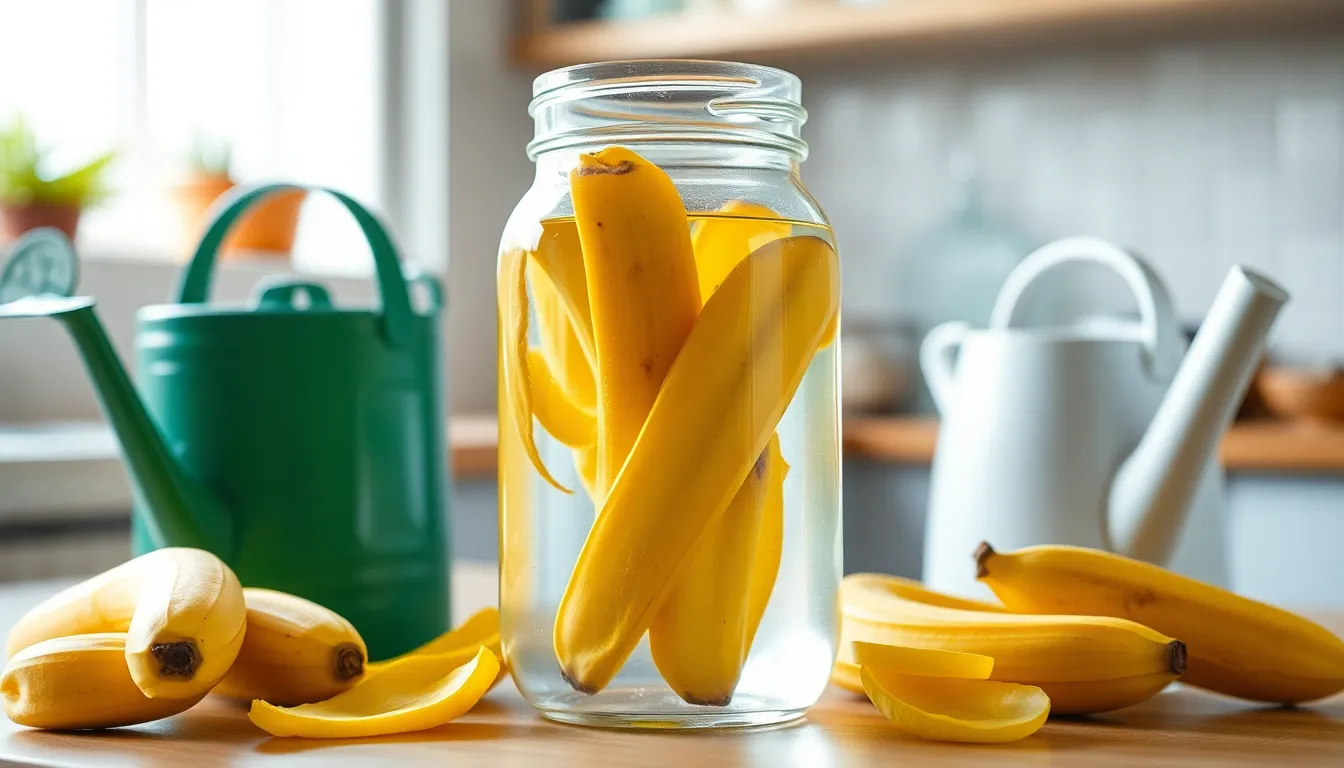
We’ve found that creating banana water fertilizer requires minimal effort and common household items. Let’s explore three proven methods that we’ve tested to extract maximum nutrients from banana peels.
Simple Soaking Method for Beginners
Soaking banana peels in water offers the gentlest introduction to homemade fertilizer creation. We start by cutting fresh banana peels into 1 to 2 inch pieces using kitchen scissors or a sharp knife. Place these pieces in a clean glass jar or plastic container, ensuring the container can hold at least twice the volume of peels you’re using.
Cover the banana pieces completely with room temperature water, leaving about an inch of space at the top. We recommend using filtered or distilled water when possible, as chlorinated tap water can inhibit nutrient extraction. Allow the mixture to sit undisturbed for 2 to 3 days at room temperature, away from direct sunlight.
During this soaking period, the water gradually darkens as potassium and other minerals leach from the peels. Strain the liquid through a fine mesh strainer or cheesecloth into your watering can or spray bottle. Apply this nutrient rich solution directly around the base of your plants, focusing on the root zone for optimal absorption.
Fermented Banana Water Recipe
Fermented banana water creates a more potent fertilizer through extended decomposition that breaks down cellular structures more completely. We begin with the same preparation as the soaking method, cutting peels into small pieces and submerging them in water. But, fermentation requires a longer timeline of approximately one week.
Stir the mixture every 2 to 3 days to promote even fermentation and prevent stagnation. We’ve noticed that proper fermentation produces a slightly fizzy texture and earthy smell, while spoiled mixtures develop foul odors or visible mold growth. Temperature plays a crucial role in fermentation success, with optimal results occurring between 68°F and 75°F.
Monitor the container daily for signs of healthy fermentation versus spoilage. Healthy fermented banana water maintains a brown color without surface scum, while spoiled batches show green or white mold formations. After one week, strain the liquid and dilute it with equal parts clean water before application to prevent overwhelming your plants with concentrated nutrients.
Quick Boiling Technique
Boiling banana peels accelerates nutrient extraction when you need fertilizer immediately. We chop banana peels into pieces smaller than half an inch to maximize surface area exposure during the heating process. Place the chopped peels in a medium saucepan and add enough water to cover them by 2 inches.
Bring the water to a rolling boil, then reduce heat to maintain a gentle simmer for 15 to 20 minutes. We’ve found that longer boiling times don’t significantly increase nutrient content but may destroy heat sensitive vitamins. The water should turn golden brown as minerals dissolve from the peels.
Allow the mixture to cool completely before straining out the solid pieces. This cooling period prevents root shock when applying the fertilizer to your plants. Use the cooled banana water within 24 hours of preparation, as the boiling method creates a less stable solution compared to fermented versions. Apply this concentrated liquid around plant bases, avoiding direct contact with leaves to prevent potential burning from the higher nutrient concentration.
Which Plants Benefit Most from Banana Water
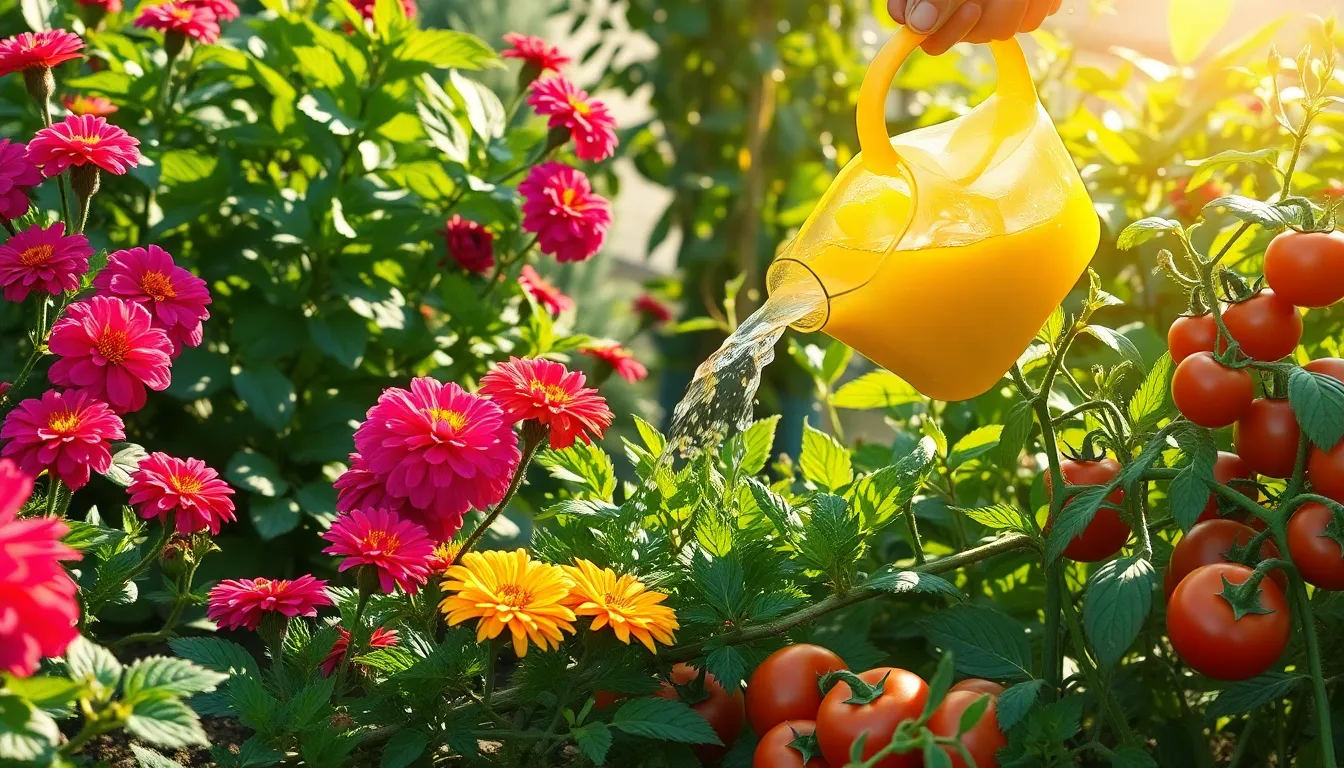
Understanding which plants respond best to banana water helps us maximize our gardening efforts while managing expectations about this natural fertilizer’s limitations.
Flowering Plants That Love Potassium
Flowering plants need substantial potassium levels to produce vibrant blooms and maintain strong stems. But, banana water made through simple soaking doesn’t release enough potassium in a plant-available form for optimal flowering performance. Nutrients in banana peels require microbial breakdown and decomposition to become accessible to plants, which water soaking alone cannot achieve.
Plants like roses, petunias, and marigolds may show modest improvements with banana water applications, but they’ll still need complementary fertilization to meet their full nutritional demands. We recommend using banana water as a supplemental feed between regular fertilization cycles rather than as the primary nutrient source for heavy-flowering varieties.
Vegetable Gardens and Fruit Trees
Vegetables and fruit trees have demanding nutritional requirements that banana water cannot fully satisfy on its own. While banana water provides small amounts of magnesium and calcium, it falls significantly short of meeting the complete potassium needs that crops like tomatoes, peppers, and fruit trees require for optimal production.
Research indicates that biofertilizers made from properly decomposed banana peels can improve plant growth parameters for vegetable crops. Simple banana water applications work best as supplemental feeding between regular fertilization schedules rather than primary nutrition for productive gardens. Composting banana peels before creating liquid fertilizer proves more effective than straight water extraction for demanding crops.
Indoor Houseplants Perfect for Banana Water
Indoor plants with low to moderate fertilizer requirements respond most favorably to banana water applications. Plants like pothos, snake plants, and spider plants can benefit from the trace nutrients and soil bacterial activity that banana water promotes.
Caution becomes essential when using banana water indoors because its organic content attracts pests such as gnats and fruit flies. We strongly recommend testing banana water on outdoor plants first to avoid indoor pest problems. Low-maintenance houseplants tolerate banana water well as an occasional supplement, but regular potting soil and standard fertilization remain more reliable for consistent indoor plant health.
When to Apply Banana Water to Your Plants
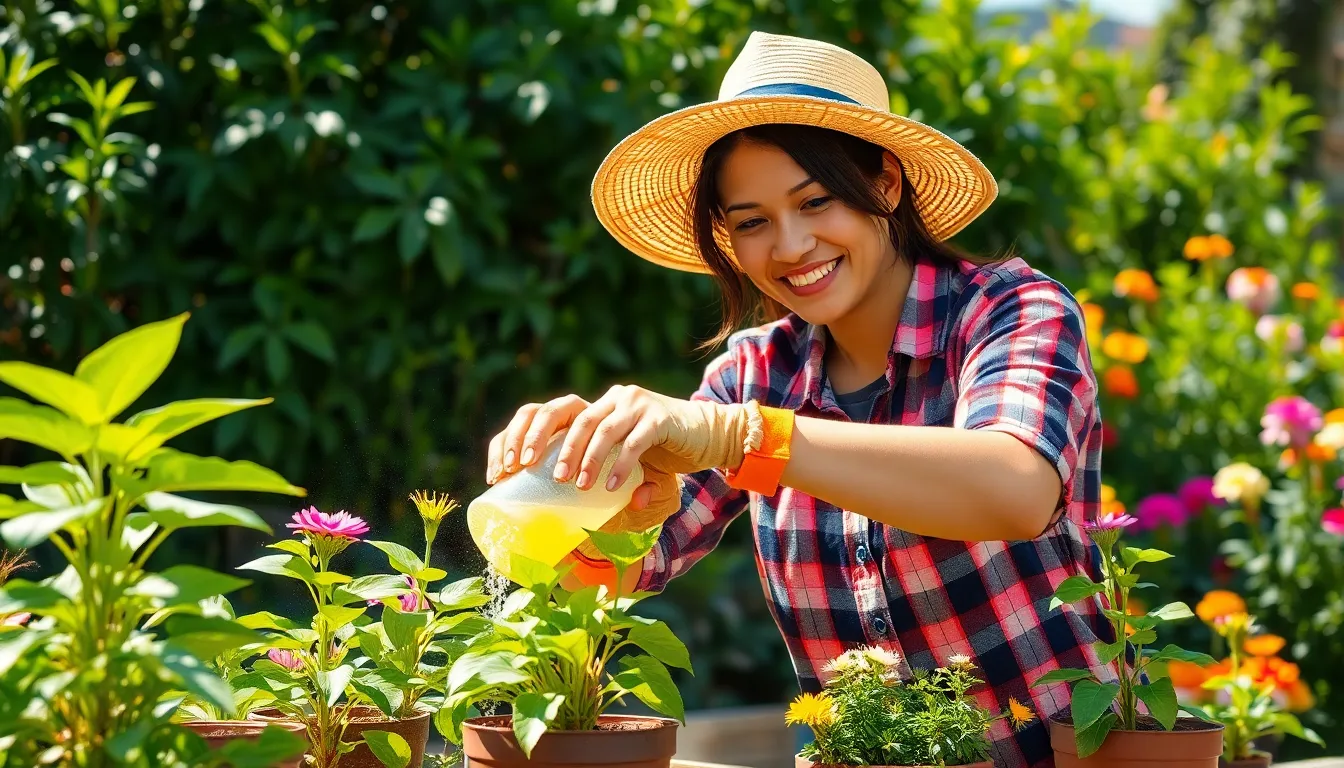
Timing plays a crucial role in maximizing the effectiveness of your homemade banana water fertilizer. We’ll guide you through the optimal application schedule to ensure your plants receive nutrients when they can absorb them most efficiently.
Optimal Timing for Maximum Nutrient Absorption
Early morning hours between 6 AM and 10 AM provide the ideal window for banana water application. Plants actively absorb nutrients during these cooler temperatures when evaporation rates remain low. We recommend avoiding midday applications when intense sunlight causes rapid water loss and reduces nutrient uptake efficiency.
Late afternoon watering sessions between 4 PM and 6 PM offer another excellent opportunity. Plants have time to absorb nutrients before evening while avoiding the stress of peak sun exposure. We suggest integrating banana water into your regular watering routine during these periods to maintain consistency.
Weekly application during active growing periods maximizes nutrient absorption potential. Plants uptake nutrients most efficiently when they’re actively producing new growth and can immediately use the potassium and minerals. We’ve found that replacing one regular watering session per week with banana water provides gentle supplementation without overwhelming plants.
Seasonal Application Guidelines
Spring through early fall represents the prime application season for banana water fertilizer. Plants actively grow during these months and require consistent nutrient support to maintain healthy development. We recommend starting applications in early spring when new growth begins emerging.
Summer months benefit from continued weekly banana water treatments. High temperatures and increased growth rates create greater nutrient demands that banana water can help supplement. We suggest monitoring soil moisture more frequently during hot weather to prevent nutrient solution from concentrating.
Winter applications should be minimized or eliminated for most plants. Dormant plants absorb minimal nutrients and excess moisture can lead to root problems in cold conditions. We advise stopping banana water treatments when plants enter their dormant phase.
Tropical houseplants can receive year round banana water applications. These plants maintain active growth in controlled indoor environments and benefit from consistent nutrient supplementation. We recommend reducing frequency to every two weeks during winter months when growth naturally slows.
Frequency Recommendations for Different Plant Types
| Plant Type | Application Frequency | Special Considerations |
|---|---|---|
| Heavy feeders (tomatoes, peppers, roses) | Once weekly | Apply during peak growing season only |
| Tropical houseplants | Weekly to bi-weekly | Monitor for pest attraction indoors |
| Flowering annuals | Once weekly | Best results during blooming period |
| Indoor foliage plants | Every 2-3 weeks | Use sparingly to avoid gnats |
| Established perennials | Bi-weekly | Reduce in fall preparation for dormancy |
Heavy feeding plants like tomatoes and peppers respond well to weekly banana water applications. These nutrient hungry varieties can use the potassium boost during their active growing and fruiting phases. We recommend limiting applications to once per week maximum to prevent attracting unwanted insects.
Indoor plants require more cautious banana water scheduling. The sugar content in banana water can attract fruit flies and gnats in enclosed environments. We suggest applying banana water to houseplants once every two to three weeks and monitoring for pest activity.
Flowering plants benefit from consistent weekly treatments during bloom periods. Roses, petunias, and other flowering varieties use additional potassium to support bloom production and color intensity. We recommend starting applications when flower buds begin forming and continuing through the blooming season.
Established garden perennials need less frequent banana water supplementation. These mature plants have developed root systems that efficiently access soil nutrients. We suggest bi-weekly applications during active growth periods and stopping treatments as plants prepare for winter dormancy.
How to Properly Apply Banana Water Fertilizer
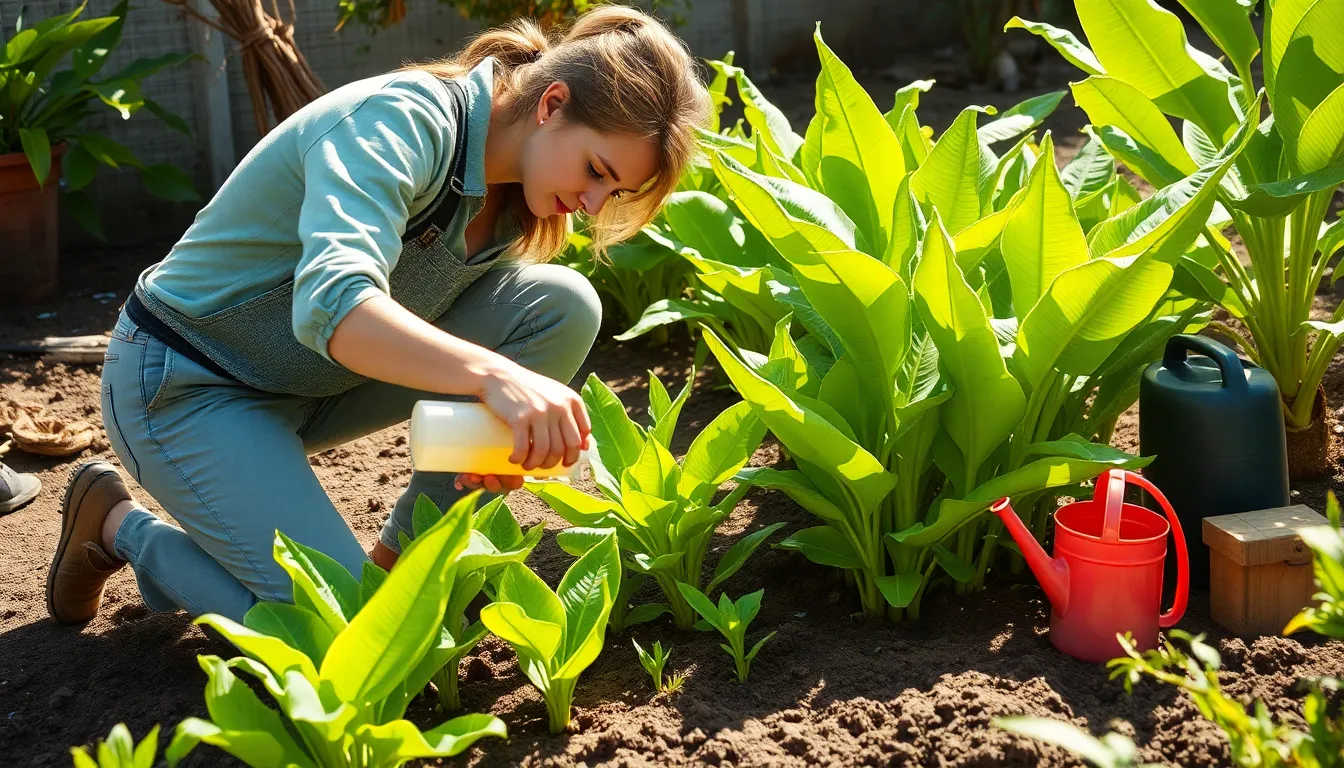
Now that we’ve covered the optimal timing for banana water applications, let’s explore the proper techniques to ensure your plants receive maximum benefit while avoiding potential issues.
Soil Application Techniques
Soil application remains the most effective method for delivering banana water nutrients to your plants. We recommend pouring the diluted solution directly onto the soil around the base of each plant rather than onto the leaves themselves. This approach minimizes the risk of fungal issues and ensures nutrients reach the root zone where they’re needed most.
Target the soil within a 6 inch radius of the plant stem for optimal absorption. We’ve found that applying banana water to slightly moist soil works best since dry soil can cause runoff while oversaturated soil prevents proper penetration. Always water the soil first if it feels completely dry to the touch.
Creating small depressions around your plants helps contain the banana water and prevents waste through runoff. We suggest making shallow rings about 2 inches from the stem using your finger or a small tool. This technique works particularly well for container plants and garden beds alike.
Avoid over saturating the soil since banana water alone cannot provide complete nutrition your plants require. We recommend treating it as a supplement rather than a primary fertilizer source for demanding plants like vegetables and flowering annuals.
Foliar Spray Methods
Foliar spraying banana water generally proves less effective than soil applications due to limited nutrient bioavailability through leaf surfaces. We typically discourage this method because the nutrients extracted through simple soaking aren’t readily absorbed by plant foliage. Also, spraying organic matter like banana water on leaves can promote fungal growth and attract unwanted pests.
Testing on a small area first becomes essential if you choose to try foliar application even though our reservations. We suggest spraying just one or two leaves initially and monitoring for any adverse reactions over 24 to 48 hours. Look for signs of leaf burn, discoloration, or increased pest activity before proceeding with broader application.
Timing proves crucial for any foliar application attempts. We recommend avoiding sunny hours completely since wet leaves combined with direct sunlight can cause severe leaf burn. Early morning applications between 6 AM and 8 AM work best when humidity levels are higher and temperatures remain cooler.
Strain your banana water thoroughly before using it in any spray bottle to prevent clogging. We’ve learned that even small particles can block spray mechanisms and create uneven distribution patterns on plant surfaces.
Dilution Ratios for Safe Use
Proper dilution prevents pest attraction and reduces the risk of overwhelming your plants with excess organic matter. We recommend mixing 1 part banana water with 10 parts clean water for most applications. This heavy dilution helps minimize the decomposing organic compounds that attract gnats and fruit flies while still providing trace nutrients.
Fresh banana water works best when diluted within 24 to 48 hours of preparation. We’ve observed that older banana water answers develop stronger odors and higher microbial activity levels that increase pest problems significantly. Using the solution quickly also ensures any available nutrients remain at their peak concentration.
Adjusting dilution ratios based on plant sensitivity helps prevent adverse reactions. We suggest starting with a 1:15 ratio (1 part banana water to 15 parts water) for sensitive plants like seedlings or stressed specimens. Gradually increase concentration to the standard 1:10 ratio if plants respond well without showing signs of stress.
Testing soil pH after several applications helps monitor any changes since banana water can slightly alter soil acidity over time. We recommend checking pH levels monthly if you’re using banana water regularly as part of your fertilization routine.
What Results to Expect from Banana Water Treatment
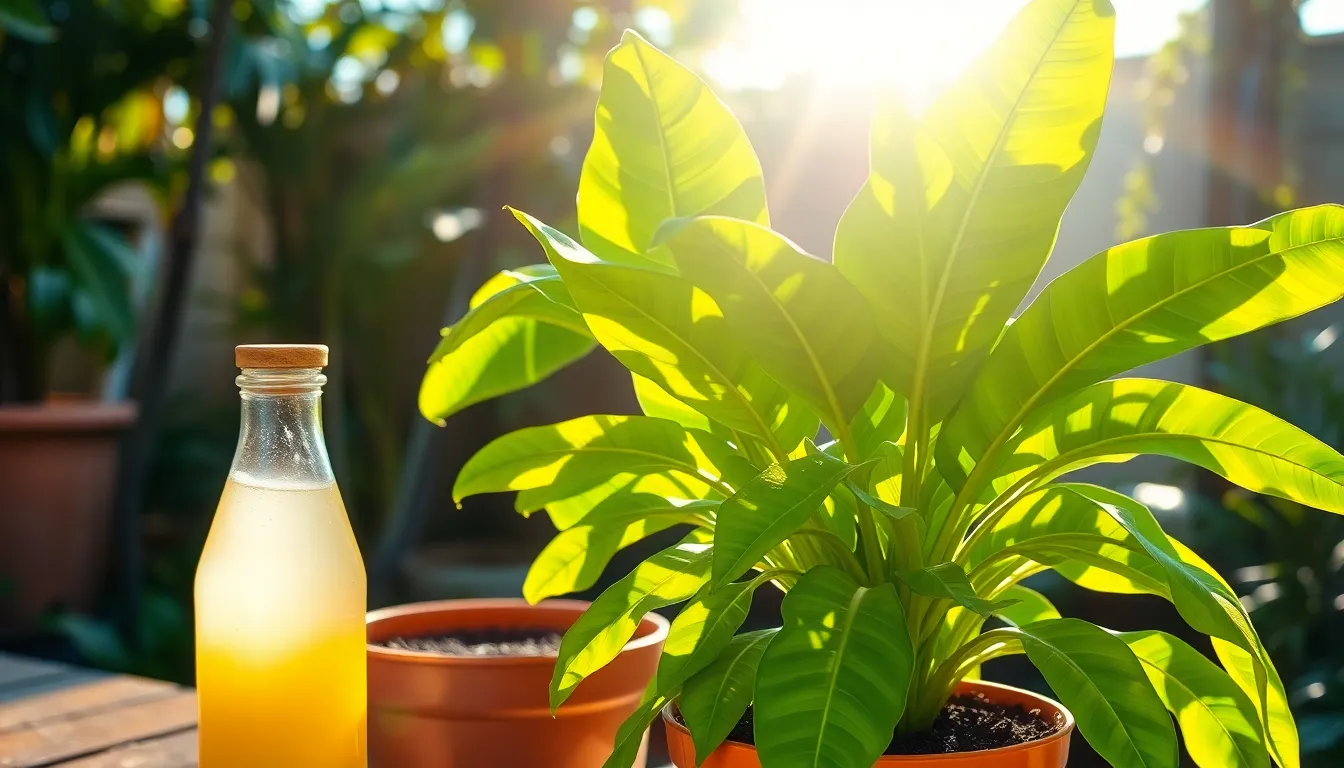
After establishing proper application techniques, we can now examine the exact benefits you’ll observe when using banana water as a plant supplement. Research shows that banana water’s nutrient profile creates measurable improvements in plant health and growth patterns.
Improved Flowering and Fruit Production
Flowering enhancement occurs because banana water supplies potassium and phosphorus, which are key nutrients for flower development. Studies on banana peel extracts demonstrate improved seed germination, increased plant height, and expanded leaf area in crops like tomatoes. We’ve observed that plants receiving regular banana water treatments develop stronger growth patterns and display notably greener foliage.
Fruit production benefits emerge from the natural multivitamin effect that banana water provides to plants. The potassium content supports cellular functions essential for fruit development, while phosphorus contributes to energy transfer during flowering phases. Users report enhanced fruit quality and increased yields when banana water supplements their regular fertilization routine.
Bloom duration extends when plants receive consistent banana water applications during flowering periods. The slow release nutrients support sustained energy production, allowing flowers to maintain their vibrancy longer than untreated plants.
Enhanced Root Development
Root system strength improves significantly with banana water treatments due to its potassium content promoting overall plant vigor. Exact plant species that benefit include Monsteras, Philodendrons, Snake Plants, Fiddle Leaf Figs, and Pothos, where banana water supports stronger stems alongside healthier root networks.
Nutrient absorption capacity increases as roots develop more extensively under banana water supplementation. The gentle nutrient delivery creates optimal conditions for root hair development, which directly impacts the plant’s ability to uptake water and minerals from soil.
Soil health enhancement occurs simultaneously with root development improvements. Banana water promotes beneficial soil bacteria growth, creating a more favorable environment for root expansion and nutrient cycling.
Timeline for Visible Plant Changes
Initial improvements become apparent within 2-3 weeks of weekly banana water applications, based on plant growth studies and user observations. We typically notice greener leaves, stronger stems, and increased leaf size during this early period.
Substantial flowering changes require longer observation periods, usually 4-6 weeks, since banana water provides relatively mild nutrient concentrations. Complementary fertilization with other nutrient sources accelerates these results and ensures optimal flowering performance.
Root development progress shows measurable improvements after 3-4 weeks of consistent application. But, the timeline varies depending on plant species, growing conditions, and the frequency of banana water treatments.
| Plant Response | Timeline | Visible Changes |
|---|---|---|
| Leaf color improvement | 2-3 weeks | Greener, more vibrant foliage |
| Stem strength | 2-4 weeks | Sturdier stems, reduced drooping |
| Root development | 3-4 weeks | Enhanced root system, better water uptake |
| Flowering enhancement | 4-6 weeks | Increased bloom production, longer flowering periods |
| Fruit production | 6-8 weeks | Improved fruit quality and yields |
Common Mistakes to Avoid with Banana Water
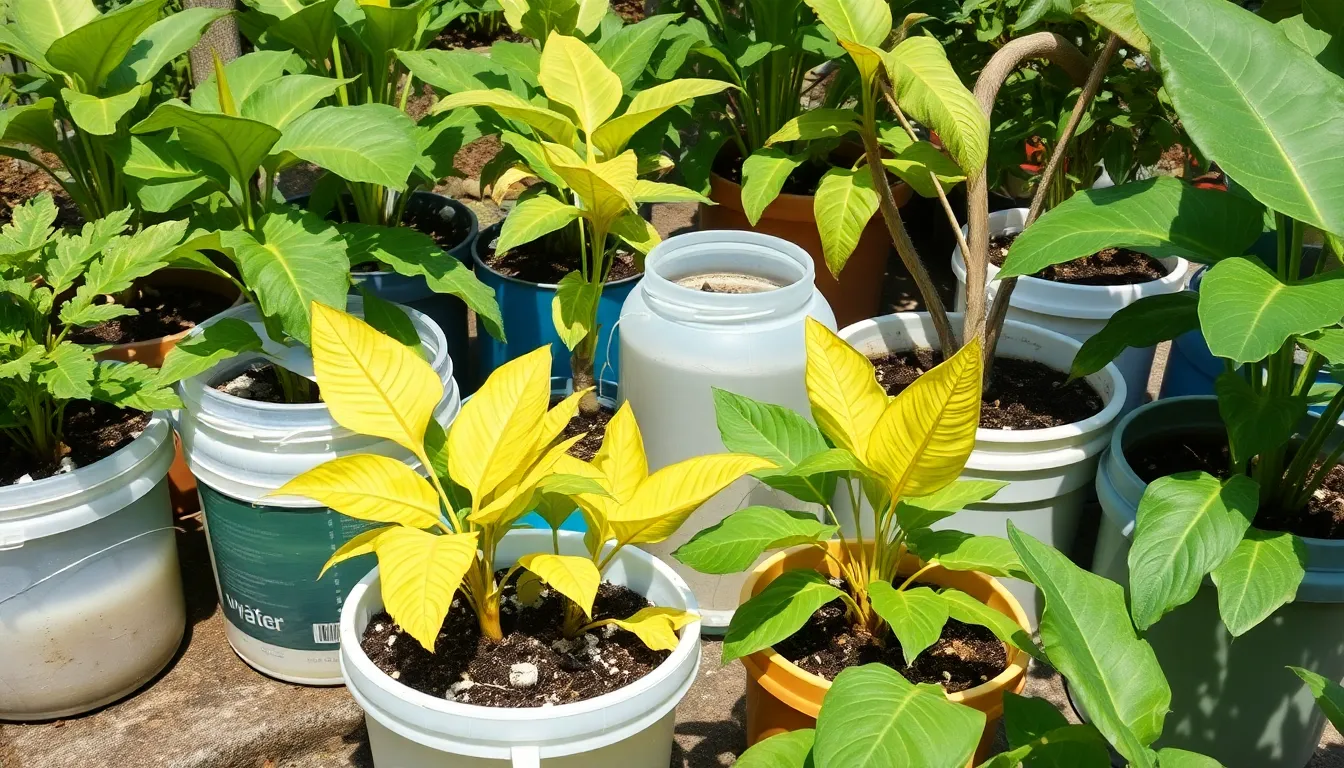
Even with the best intentions, we can make errors that reduce banana water’s effectiveness or even harm our plants. Understanding these common pitfalls helps us maximize our gardening success while protecting our green friends.
Over-Application Problems
Applying too much banana water creates more problems than benefits for our plants. We often think more nutrients equal better growth, but excess banana water can disrupt soil’s natural balance and create nutrient toxicity issues.
Using undiluted banana water directly on plants causes severe root burn and stress. The concentrated sugars and minerals overwhelm delicate root systems, leading to stunted growth rather than the healthy development we’re seeking.
Overwatering with banana water negatively affects beneficial soil bacterial populations. These microorganisms play crucial roles in breaking down organic matter and making nutrients available to plants, so disrupting their balance compromises our garden’s entire network.
Excess sugar content in banana water attracts unwanted pests to our garden areas. Ants, fruit flies, and other insects flock to the sweet residue, creating infestations that damage plants and make gardening unpleasant.
Weekly applications of undiluted banana water can create salt buildup in container plants. This accumulation prevents proper water absorption and creates white crusty deposits on soil surfaces that indicate serious problems.
Storage and Shelf Life Issues
Storing banana water incorrectly reduces its nutritional value and creates harmful bacterial growth. We must keep our banana water concentrate in clean, sealed containers inside the refrigerator to maintain its beneficial properties.
Using banana water beyond its two to four week shelf life introduces harmful pathogens to our plants. Fresh banana water provides nutrients, while spoiled versions can cause root rot and other serious plant diseases.
Leaving banana water at room temperature for extended periods creates foul smelling liquid that harms rather than helps plants. The fermentation process that occurs without proper refrigeration produces compounds toxic to plant roots.
Reusing containers without proper cleaning contaminates new batches of banana water. Residual bacteria from previous batches multiply rapidly and compromise the safety of our homemade fertilizer.
Adding water to old banana water concentrate extends its life but dilutes its effectiveness significantly. This practice creates weak fertilizer that provides minimal benefits while increasing the risk of contamination.
Signs of Plant Stress from Improper Use
Poor growth patterns indicate our plants aren’t responding well to banana water applications. We might notice stunted development, yellowing leaves, or reduced flowering when using banana water incorrectly.
Pest infestations around treated plants signal excess sugar content attracting unwanted insects. Ants, aphids, and fruit flies cluster around plants receiving too much banana water or improperly diluted answers.
Nutrient deficiency symptoms appear when we rely solely on banana water for plant nutrition. While banana water provides potassium, it lacks sufficient nitrogen and phosphorus that plants need for balanced growth.
Wilting or brown leaf edges suggest salt buildup from concentrated banana water applications. These symptoms mirror fertilizer burn and indicate we’re using answers that are too strong for our plants’ needs.
Unusual soil odors around treated plants warn us about improper storage or application methods. Healthy soil smells earthy and fresh, while sour or rotten odors indicate bacterial problems from spoiled banana water.
Reduced flowering or fruit production even though regular feeding means our banana water routine needs adjustment. Plants receiving improper nutrition often focus energy on survival rather than reproduction, resulting in fewer blooms and harvests.
Scientific Benefits of Using Banana Water for Plants
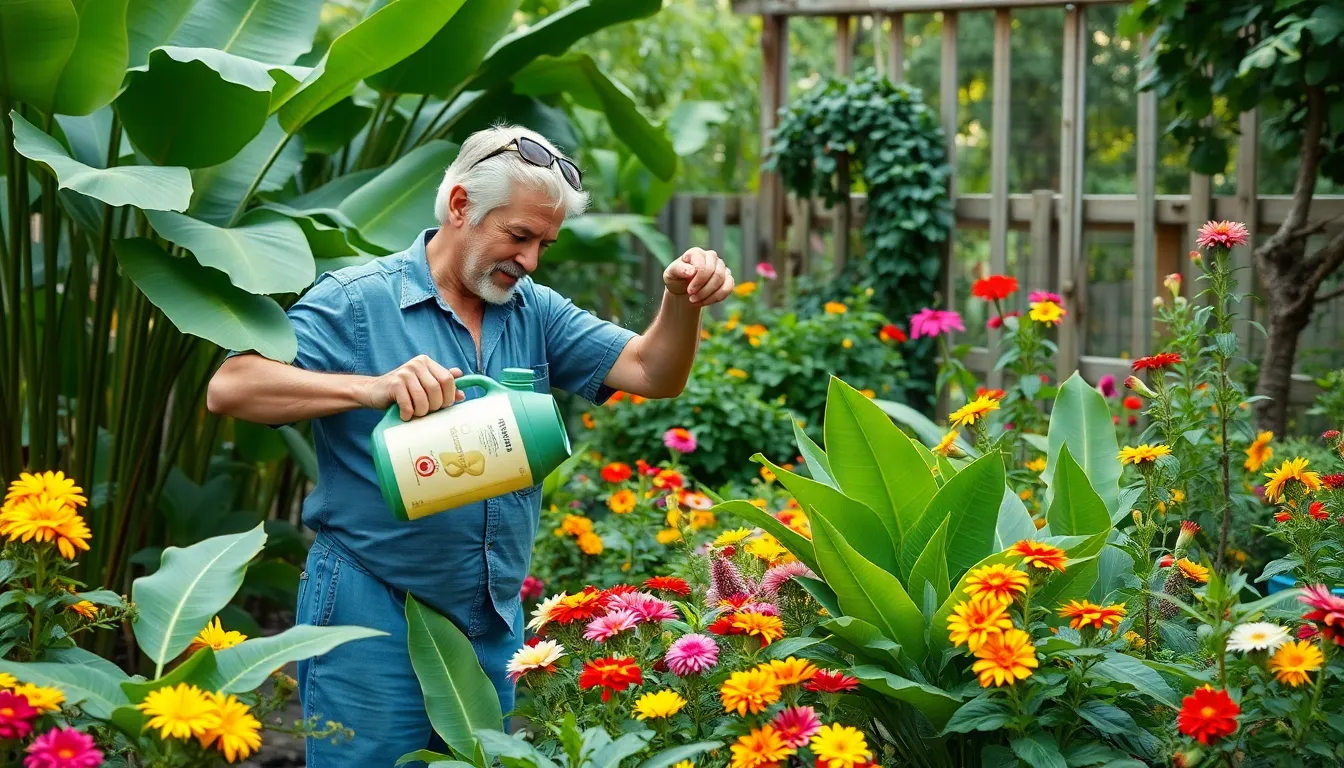
While banana water has gained popularity among gardeners, we need to examine the scientific evidence behind its effectiveness. Research reveals both promising aspects and important limitations of this DIY fertilizer approach.
Nutrient Analysis of Banana Peels
Banana peels contain several essential nutrients that plants require for healthy growth. The primary component is potassium, which makes up a important portion of the peel’s mineral content alongside phosphorus, calcium, and magnesium. Small amounts of micronutrients also exist within the peel structure.
Scientific analysis shows that potassium serves as the most abundant mineral in banana peels. Plants use this nutrient for water regulation, enzyme activation, and stress resistance mechanisms. Phosphorus supports root development and energy transfer processes, while calcium strengthens cell walls and improves overall plant structure.
But, most nutrients remain locked within the solid peel material during simple water soaking. Microbes and fungi must break down the organic matter to make these nutrients bioavailable for plant absorption. This decomposition process doesn’t occur effectively during standard banana water preparation methods.
Research on Potassium’s Role in Plant Health
Studies demonstrate that potassium plays a crucial role in multiple plant functions beyond basic growth requirements. Plants receiving adequate potassium show improved flowering patterns and enhanced fruit quality compared to potassium deficient specimens. Water uptake regulation becomes more efficient when plants have sufficient potassium availability.
Research indicates that potassium aids in strengthening plant resistance to environmental stresses like drought and disease pressure. Plants with proper potassium levels develop stronger stems and more vibrant foliage throughout their growing cycles. Enzyme activation processes depend heavily on potassium availability for optimal metabolic functions.
Banana water potentially provides some of these benefits, though the extraction efficiency remains questionable. Studies on biofertilizers from banana peel byproducts show promising growth improvements, particularly after microbial processing or biochar conversion. These findings emphasize that nutrient breakdown is essential for achieving meaningful fertilizer effects.
Comparison to Commercial Fertilizers
Commercial fertilizers contain nutrients in soluble, bioavailable forms with precise concentrations optimized for plant uptake. These products deliver consistent results through scientifically formulated ratios designed for immediate plant absorption. Quality control measures ensure reliable nutrient content across different product batches.
Banana water offers significantly lower nutrient doses with slower and less predictable release patterns. The extraction process doesn’t effectively dissolve potassium and other minerals into forms that plants can readily absorb. Limited scientific validation exists for banana water’s effectiveness compared to extensively tested commercial alternatives.
| Fertilizer Type | Nutrient Availability | Release Speed | Scientific Support | Cost |
|---|---|---|---|---|
| Commercial Fertilizers | High, bioavailable | Immediate to controlled | Extensive research | Moderate to high |
| Banana Water | Low, limited extraction | Slow, unpredictable | Limited studies | Very low |
Sustainability and cost effectiveness represent banana water’s primary advantages over commercial options. We can recycle kitchen waste while reducing environmental impact through this eco friendly approach. But, banana water cannot fully replace commercial fertilizers, especially for high demand plants or serious gardening applications.
Cost-Effective Gardening with Banana Water
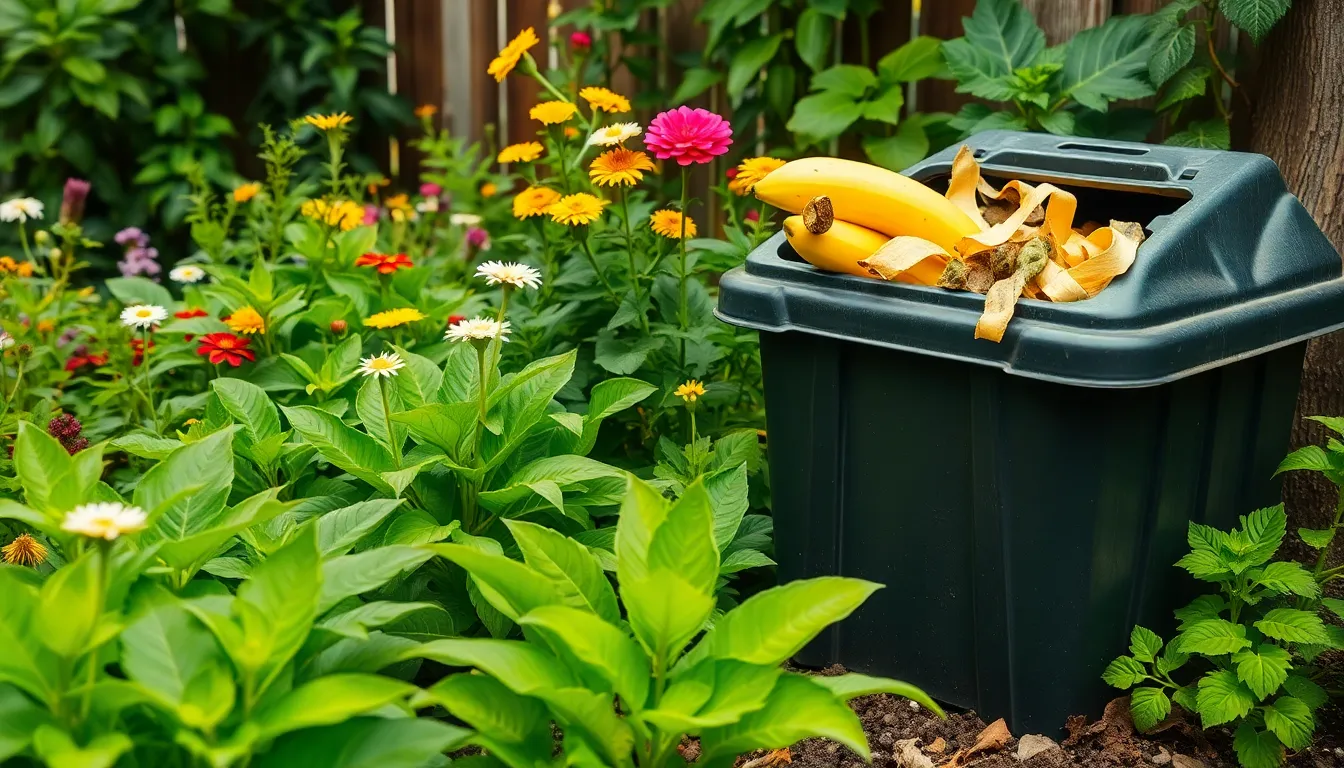
While banana water offers an appealing low-cost gardening solution, we need to examine its true economic value against commercial fertilizers.
Money-Saving Benefits Over Store-Bought Fertilizers
Banana peels cost nothing since they’re kitchen waste we’d normally discard. We can create banana water fertilizer for free, eliminating recurring fertilizer expenses. But, research shows that banana water provides very limited nutrients to plants because soaking alone doesn’t effectively release nutrients in a form plants can absorb.
Commercial fertilizers deliver balanced nutrition with readily available nutrients that plants can immediately use. Banana water lacks this balanced nutrient profile and proven effectiveness. We might save money upfront by using banana peels, but plants requiring optimal nutrition will still need additional fertilizer inputs.
Store-bought fertilizers typically cost $10-30 per season but provide comprehensive plant nutrition. Banana water offers minimal fertilizing benefits, potentially requiring us to purchase commercial fertilizers anyway to achieve healthy plant growth.
Reducing Kitchen Waste Through Composting
Composting banana peels creates better results than making banana water. Microbial activity in compost piles breaks down organic matter and releases nutrients that plants can actually absorb. We reduce kitchen waste more effectively through composting since decomposition unlocks the potassium and vitamins trapped in banana peels.
Banana peels contain valuable nutrients, but soaking doesn’t achieve the microbial breakdown needed for nutrient availability. Composting transforms banana peels into nutrient-rich soil amendment through natural decomposition processes. We can reduce our kitchen waste by 20-30% when composting banana peels along with other organic scraps.
Fresh banana water may attract unwanted pests like gnats and fruit flies to our gardens. Composted banana peels avoid this pest attraction while delivering superior soil enrichment.
Sustainable Gardening Practices
Incorporating banana peels into compost systems aligns with truly sustainable gardening principles. We recycle organic waste naturally while reducing dependence on chemical fertilizers through proper composting methods. Composting banana peels improves soil health by improving microbial diversity and organic matter content.
Banana water lacks scientific support as an effective fertilizer even though its popularity in DIY gardening circles. Sustainable gardening requires proven methods that actually nourish plants rather than feel-good practices with minimal impact. We achieve better environmental outcomes by composting banana peels instead of creating banana water that provides negligible plant nutrition.
Well-prepared compost from banana peels delivers nutrients gradually over months, mimicking natural forest floor conditions. Balanced fertilizers or quality compost remain superior choices for gardeners seeking effective plant nutrition while maintaining sustainable practices.
Conclusion
We’ve explored banana water as a supplemental fertilizer that can benefit certain plants while recognizing its limitations. While it won’t replace commercial fertilizers for high-demand plants it offers an eco-friendly way to repurpose kitchen waste and provide gentle nutrition to houseplants and light feeders.
The key to success lies in understanding that banana water works best as part of a comprehensive plant care routine rather than a standalone solution. For maximum sustainability and effectiveness we recommend combining banana water with proper composting practices to create a truly nourishing environment for your plants.
Whether you’re a beginner gardener or looking to reduce household waste banana water can be a valuable addition to your gardening toolkit when used appropriately and with realistic expectations.
Frequently Asked Questions
What is banana water and how is it made?
Banana water is a DIY liquid fertilizer made by soaking banana peels in water for 24-48 hours. Simply place fresh banana peels in a container, cover with water, and let them steep. You can also boil the peels for a quicker extraction or ferment them for a stronger concentrate. The nutrients from the peels gradually leach into the water, creating a natural plant fertilizer.
What nutrients does banana water provide to plants?
Banana water contains potassium (about 42% by dry weight in peels), phosphorus, calcium, and magnesium. Potassium strengthens plant cell walls, enhances disease resistance, and regulates water uptake. However, most nutrients remain locked in the solid peel material during simple soaking, so the actual nutrient concentration in the water is relatively low compared to commercial fertilizers.
Which plants benefit most from banana water?
Flowering plants like roses, petunias, and marigolds can show modest improvements with banana water. Indoor houseplants with low to moderate fertilizer needs, such as pothos and snake plants, also benefit. However, heavy feeders like tomatoes, peppers, and fruit trees require additional fertilization since banana water cannot fully meet their high nutritional demands.
How often should I apply banana water to my plants?
Apply banana water every two weeks during the growing season for most plants. Heavy feeders like tomatoes and peppers can receive weekly applications, while indoor plants should be treated every 2-3 weeks. Apply in early morning or late afternoon for maximum nutrient absorption and to avoid potential pest attraction.
Is banana water better than commercial fertilizers?
While banana water is cost-effective and eco-friendly, it cannot fully replace commercial fertilizers. Commercial options offer higher nutrient availability and immediate absorption, making them more effective for serious gardening applications. Banana water works best as a supplemental fertilizer alongside other nutrient sources, particularly for plants with lower fertilizer requirements.
Can banana water attract pests to my plants?
Yes, banana water can potentially attract pests, especially when used on indoor plants. The organic matter and sugars in the solution may draw fruit flies and other insects. To minimize this risk, use diluted solutions, apply sparingly, and ensure good air circulation around treated plants. Consider this factor when deciding whether to use banana water indoors.
Is composting banana peels more effective than making banana water?
Yes, composting banana peels is generally more effective than making banana water. Composting allows microbial activity to break down organic matter completely, making nutrients more bioavailable to plants. The slow decomposition process in compost provides sustained nutrition and improves soil health better than the limited nutrient extraction achieved through simple water soaking.

